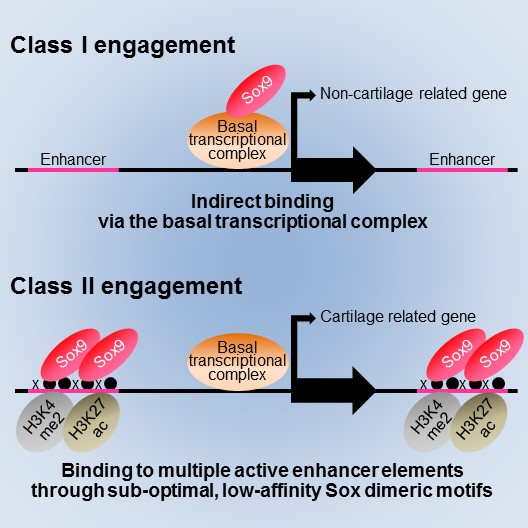Transcriptional mechanisms governing cartilage formation

Model for two distinct modes of Sox9 action in cartilage formation proposed in the present study. In Class I engagement, Sox9 binds to the genome indirectly via the basal transcriptional complex, regulating transcription of genes for basal cell activities. In Class II engagement, Sox9 binds to multiple active enhancer elements through sub-optimal, low-affinity Sox dimeric motifs (DNA sequences), resulting in a high level of transcription of cartilage-related genes. © 2015 Shinsuke Ohba.
Researchers at the University of Tokyo have identified modes of Sox9 action during cartilage formation by analyzing big data on Sox9 location, chromatin state, and gene expression over the whole mouse genome.
This finding will contribute to the understanding of cartilage diseases caused by genomic mutation and genome-based drug discovery for disease therapies.
Cartilage generated in embryos not only regulates skeletal growth until puberty, but also plays a key role in our locomotion as articular cartilage in our joints. Cartilage formation (chondrogenesis) requires the normal function of Sox9, a protein that regulates the expression of chondrogenesis-related genes.
Mutation around the region of the human SOX9 gene, which encodes the Sox9 protein, causes campomelic dysplasia, a congenital disease that is accompanied by skeletal abnormalities and other conditions.
Although the mechanisms underlying Sox9-mediated transcriptional regulation during chondrogenesis have been intensively investigated at a certain genomic region, its genome-wide regulation remained unclear.
Project Associate Professor Shinsuke Ohba at the Department of Bioengineering, the University of Tokyo Graduate School of Engineering, identified two genome-wide modes (Class I and Class II engagement) of Sox9 action in transcription during chondrogenesis.
In Class I engagement, Sox9 binds indirectly to the DNA and regulates the transcription of genes involved in basal cell activities. In Class II engagement, it binds directly to the DNA in multiple locations and activates transcription of cartilage-related genes.
“This finding will contribute to the understanding of cartilage-related degenerative diseases and congenital abnormalities that are caused by genomic mutation and genome-based drug discovery for treatment of diseases and cartilage regeneration,” says Ohba.
This work was published in the online version of Cell Reports (Cell Press) on July 2, 2015. This research was carried out in collaboration with Professor Andrew P. McMahon at the University of Southern California.
Paper
Shinsuke Ohba, Xinjun He, Hironori Hojo, Andrew P. McMahon, “Distinct transcriptional programs underlie Sox9 regulation of the mammalian chondrocyte”, Cell Reports Online Edition: 2015/7/3 (Japan time), doi: 10.1016/j.celrep.2015.06.013.
Associated links
U Tokyo Research article
Media Contact
More Information:
http://www.researchsea.comAll latest news from the category: Life Sciences and Chemistry
Articles and reports from the Life Sciences and chemistry area deal with applied and basic research into modern biology, chemistry and human medicine.
Valuable information can be found on a range of life sciences fields including bacteriology, biochemistry, bionics, bioinformatics, biophysics, biotechnology, genetics, geobotany, human biology, marine biology, microbiology, molecular biology, cellular biology, zoology, bioinorganic chemistry, microchemistry and environmental chemistry.
Newest articles

Trotting robots reveal emergence of animal gait transitions
A four-legged robot trained with machine learning by EPFL researchers has learned to avoid falls by spontaneously switching between walking, trotting, and pronking – a milestone for roboticists as well…

Innovation promises to prevent power pole-top fires
Engineers in Australia have found a new way to make power-pole insulators resistant to fire and electrical sparking, promising to prevent dangerous pole-top fires and reduce blackouts. Pole-top fires pose…

Possible alternative to antibiotics produced by bacteria
Antibacterial substance from staphylococci discovered with new mechanism of action against natural competitors. Many bacteria produce substances to gain an advantage over competitors in their highly competitive natural environment. Researchers…





















